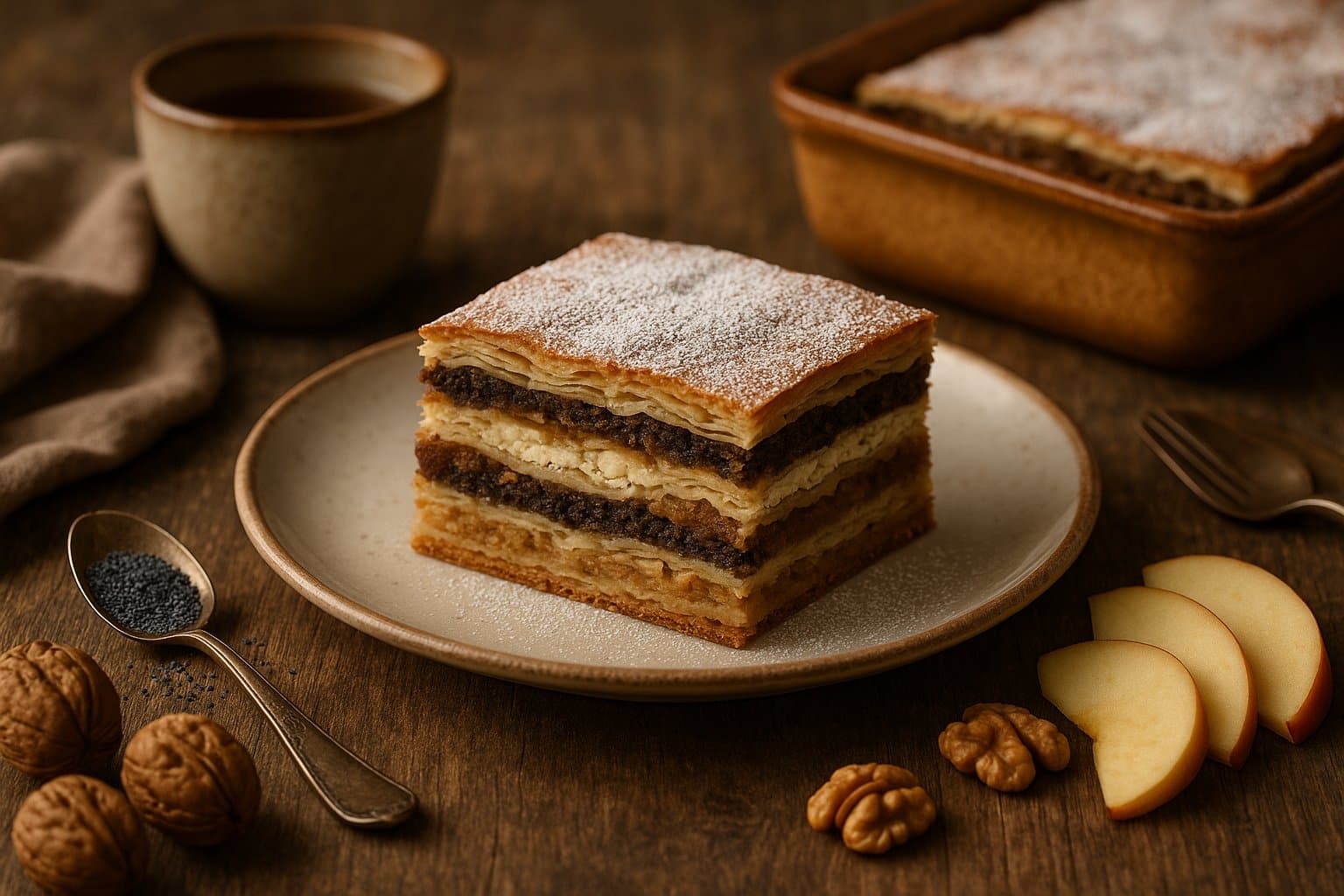Prekmurska Gibanica: Slovenia’s Layered Heritage in Every Slice

Prekmurska Gibanica: Slovenia’s Layered Heritage in Every Slice
Around the World in 80 Bakes: Stop #20 — Slovenia
In the far northeast of Slovenia, cradled between the Mura River and the Hungarian border, lies the Prekmurje region — a quiet land of low hills, fertile plains, and a deep sense of cultural pride. It is here, among apple orchards and walnut groves, that one of Slovenia’s most iconic desserts was born: the richly layered Prekmurska Gibanica ((Pronounced: prehk-MOOR-ska GHEE-bah-neet-sah).
More than a cake, it is a symbol of local identity, an embodiment of rural resourcefulness, and a link to centuries-old traditions shaped by geography, religion, and the rhythms of peasant life.
🧺 Born from the Pantry of Prekmurje
The name gibanica stems from the Slovene verb gibati, meaning “to move,” “to fold,” or “to sway.” It refers to the folding motion used when layering the cake’s many sheets of dough — but it may also hint at the way flavours and cultures have long flowed through this borderland.
Unlike western Slovenia, which was historically influenced by Austria and Italy, Prekmurje spent centuries under Hungarian rule, only becoming part of Yugoslavia (and later Slovenia) after World War I. This meant that its dialect, customs, and cuisine developed in partial isolation from the rest of the country — preserving a distinct folk character.
Prekmurska Gibanica likely emerged as a festival dish among Slovene-speaking peasants in the 18th or 19th century, though the layering concept may trace even further back to medieval or Ottoman influences via Hungary and Serbia. Local women would bake it for weddings, baptisms, harvest festivals, and Christmas — occasions that justified the use of precious ingredients: poppy seeds, walnuts, apples, cottage cheese, eggs, cream, and white flour.
These were not everyday items. They represented seasonal abundance and careful preparation — foods grown, gathered, or traded across the year. To include so many fillings in one cake was to say, this day is special.
🥮 The Sacred Order of Layers
Traditional Prekmurska Gibanica includes four fillings arranged in a precise sequence, typically repeated twice:
Poppy Seed (mak) – Symbol of fertility and good luck; poppy seeds were often used in festive pastries across Central and Eastern Europe.
Cottage Cheese or Quark (skuta) – Represents dairy farming and purity; quark was often homemade.
Ground Walnuts (orehi) – A rich, hearty ingredient, tied to autumn and rural affluence.
Apples (jabolka) – The most accessible and versatile fruit in the region; shredded apples gave natural sweetness and moisture.
Between each layer, thin sheets of pastry — traditionally hand-pulled like strudel dough — created delicate separations. These were brushed with sour cream, cream, or butter, depending on what the household had available. The result was a tall, multi-layered cake that could weigh over two kilograms — hefty, humble, and strikingly beautiful once sliced.
This methodical layering wasn’t random. It reflected order, balance, and meaning. Each bite would offer a taste of all four fillings — a kind of edible harmony that echoed the agricultural cycles and family unity it was made to celebrate.
📜 A Bake That Spoke Volumes
In traditional Prekmurje villages, where literacy was rare and history was passed down orally, dishes like Gibanica became cultural records in themselves. Recipes were memorised and taught by observation, not written down.
The first known written recipe resembling Prekmurska Gibanica appeared in the 1828 cookery manuscript of Anna Kastelec, a Slovenian noblewoman. However, the version that gained national recognition was standardised much later, in the 20th century.
During the Yugoslav era, when regional identities were sometimes discouraged in favour of pan-national unity, traditional dishes like Gibanica helped preserve a distinct local identity. For many Prekmurje families, making this cake was not just about food — it was an act of cultural resilience.
🇪🇺 From Village Tables to Protected Status
In the early 2000s, Slovenia began working to formally protect and promote its culinary heritage. Prekmurska Gibanica was recognised as a Traditional Speciality Guaranteed (TSG) by the European Union in 2010 — a designation that protects the recipe’s authenticity and method, rather than its geographical origin.
This means that even if the cake is made outside Slovenia, it can only be called “Prekmurska Gibanica” if it follows the traditional recipe, ingredients, and sequence of layers. It was only the second Slovenian food to receive TSG status, after Idrija žlikrofi (a type of dumpling).
Today, Prekmurska Gibanica is served in bakeries, cafés, and restaurants across Slovenia — often featured in wedding menus, cultural festivals, and tourist tastings. Yet it remains a dish most powerful in the home, where each family may still guard their version, passed down from mothers and grandmothers.
🍂 A Slice of Prekmurje’s Soul
Baking a Prekmurska Gibanica is an act of patience — a nod to slower days, when time was measured not by clocks but by harvests and holy days. It invites hands to work and hearts to remember. And while its layers may seem complex, they’re simply telling a story — of place, of people, and of a time when abundance was measured not by quantity, but by care.
🔗 Curious to try it at home?
Share your thoughts
Did you find this history article interesting? Rate it below and let others know!